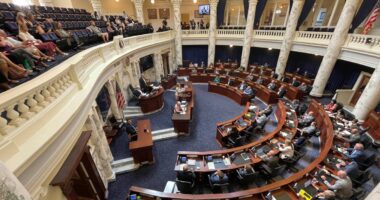
The U.S. economy is poised to grow at its fastest pace in decades, carried along by a wave of pent-up demand built during the pandemic and the trillions of dollars of support the government has provided over the past year.
But what that boom will look like—how long it will last, what it might do for employment, how much inflation it might generate—isn’t clear. The grab bag of history doesn’t offer many periods in living memory when gross domestic product grew as quickly as forecasters expect for this year, and those past experiences came about when the composition of the economy was very different from today.
Economists surveyed by IHS Markit estimate on average that real, or inflation-adjusted, GDP will be 6.7% higher in the fourth quarter of 2021 than it was a year earlier. That would mark the strongest year of growth since 1983, when the economy was, as it is now, taking off out of a deep recession. Even that could prove conservative, as there is still a measure of caution in current forecasts, reflecting the possibility that the Covid-19 crisis could flare up again.
Given the likelihood of strong growth this year, the big question facing investors, businesses, policy makers and ordinary people is what will happen next, but the most honest answer to that might be a shrug.
Some economists, including former Treasury Secretary and Obama White House economic adviser Lawrence Summers, worry that the amount of stimulus that is getting poured into the economy is excessive. Indeed, with forecasters looking for the economy to grow an additional 3.3% next year, by the end of 2022 GDP could be 2.7% above the Congressional Budget Office’s estimate of its “potential,” or the level it can sustain without running too hot. The last time GDP got that far above potential was 1973, when the U.S. was experiencing a serious inflation problem that wouldn’t be snuffed until the early 1980s.
SHARE YOUR THOUGHTS
What do you think the next economic boom will look like? Join the conversation below.
The seeds for the 1970s experience were sown in the 1960s, when spending on social programs and the Vietnam War boosted growth. However, the $5 trillion in relief that has been passed since the Covid crisis struck is a shorter-term phenomenon than the government spending of that era. As a result, a more apt analogy may be the economic boost that occurred during the Korean War, argues Joseph Gagnon, a former senior Federal Reserve economist now at the Peterson Institute for International Economics.
The U.S. was already in the midst of a swift recovery from a recession that ended in 1949 when North Korea invaded South Korea in June 1950, and ramping up for the war effort soon sent the economy into overdrive. By the fourth quarter of 1950, GDP was 13.4% above its year-earlier level. Inflation shot up, but then fell right back.
But the economic environment is very different now. The U.S. isn’t driven by manufacturing like it once was. Services, which accounted for about 40% of GDP in the 1950s, now account for about 60% of it. Many of the effects of the Covid-crisis were also unique, such as the way it hammered services like travel and restaurant spending while touching manufacturing far more lightly.
That makes it easy to spin plausible stories where things go well or poorly. For example, the work-from-home revolution the crisis helped spark might help businesses run more efficiently, boosting productivity, raising potential GDP and allowing the economy to run faster over the long run without overheating. Or, the thicket of supply-chain problems the crisis caused, and difficulties scaling up services to meet demand, could cause a more serious bout of inflation than most economists expect. Other uncertainties abound, including how successful President Biden will be getting his remaining spending and tax plans passed.
Meanwhile, what the economy does in 2021 could be surprising enough, not because it is unexpected but because it has been so long since it grew as fast as now seems likely. Most working-age Americans were just children during the 1983 boom, if they were even born yet. They are in for something new.
Write to Justin Lahart at [email protected]
Copyright ©2020 Dow Jones & Company, Inc. All Rights Reserved. 87990cbe856818d5eddac44c7b1cdeb8
This post first appeared on wsj.com








